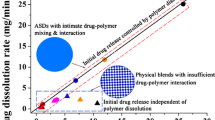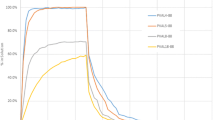ABSTRACT
Purpose
To identify the mechanism behind the unexpected bio-performance of two amorphous solid dispersions: BMS-A/PVP-VA and BMS-A/HPMC-AS.
Methods
Solubility of crystalline BMS-A in PVP-VA and HPMC-AS was measured by DSC. Drug-polymer interaction parameters were obtained by Flory-Huggins model fitting. Drug dissolution kinetics of spray-dried dispersions were studied under sink and non-sink conditions. BMS-A supersaturation was studied in the presence of pre-dissolved PVP-VA and HPMC-AS. Potency and crystallinity of undissolved solid dispersions were determined by HPLC and DSC. Polymer dissolution kinetics were obtained by mass balance calculation. Bioavailability of solid dispersions was assessed in dogs.
Results
In solid state, both polymers are miscible with BMS-A, while PVP-VA solublizes the drug better. BMS-A dissolves similarly from both solid dispersions in vitro regardless of dissolution method, while the HPMC-AS dispersion performed much better in vivo. At the same concentration, HPMC-AS is more effective in prolonging BMS-A supersaturation; this effect was negated by the slow dissolution rate of HPMC-AS. Further study revealed that fast PVP-VA dissolution resulted in elevated drug loading in undissolved dispersions and facilitated drug recrystallization before complete release. In contrast, the hydrophobicity and slower HPMC-AS dissolution prevented BMS-A recrystallization within the HPMC-AS matrix for >24 h.
Conclusions
The lower bioavailability of PVP-VA dispersion was attributed to BMS-A recrystallization within the undissolved dispersion, due to hydrophilicity and fast PVP-VA dissolution rate. Polymer selection for solid dispersion development has significant impact on in vivo performance besides physical stability.








Similar content being viewed by others
REFERENCES
Hancock BC, Zografi G. Characteristics and significance of the amorphous state in pharmaceutical systems. J Pharm Sci. 1997;86:1–12.
Hancock BC. Disordered drug delivery: destiny, dynamics and the Deborah number. J Pharm Pharmacol. 2002;54:737–46.
Yu L. Amorphous pharmaceutical solids: preparation, characterization and stabilization. Adv Drug Deliv Rev. 2001;48:27–42.
Janssens S, Van MG. den. Review: physical chemistry of solid dispersions. J Pharm Pharmacol. 2009;61:1571–86.
Serajuddin AT. Solid dispersion of poorly water-soluble drugs: early promises, subsequent problems, and recent breakthroughs. J Pharm Sci. 1999;88:1058–66.
Hancock BC, Parks M. What is the true solubility advantage for amorphous pharmaceuticals? Pharm Res. 2000;17:397–404.
Murdande SB, Pikal MJ, Shanker RM, Bogner RH. Solubility advantage of amorphous pharmaceuticals: I. A thermodynamic analysis. J Pharm Sci. 2010;99:1254–64.
Zhou D, Zhang GG, Law D, Grant DJ, Schmitt EA. Physical stability of amorphous pharmaceuticals: importance of configurational thermodynamic quantities and molecular mobility. J Pharm Sci. 2002;91:1863–72.
Angell CA. Formation of glasses from liquids and biopolymers. Science. 1995;267:1924–35.
Graeser KA, Patterson JE, Zeitler JA, Gordon KC, Rades T. Correlating thermodynamic and kinetic parameters with amorphous stability. Eur J Pharm Sci. 2009;37:492–8.
Hancock BC, Shamblin SL, Zografi G. Molecular mobility of amorphous pharmaceutical solids below their glass transition temperatures. Pharm Res. 1995;12:799–806.
Taylor LS, Zografi G. Spectroscopic characterization of interactions between PVP and indomethacin in amorphous molecular dispersions. Pharm Res. 1997;14:1691–8.
Ivanisevic I, Bates S, Chen P. Novel methods for the assessment of miscibility of amorphous drug-polymer dispersions. J Pharm Sci. Published Online: 12 Mar 2009: 2009.
Newman A, Engers D, Bates S, Ivanisevic I, Kelly RC, Zografi G. Characterization of amorphous API:polymer mixtures using x-ray powder diffraction. J Pharm Sci. 2008;97:4840–56.
Qian F, Huang J, Hussain MA. Drug-polymer solubility and miscibility: stability consideration and practical challenges in amorphous solid dispersion development. J Pharm Sci. 2010;99:2941–7.
Qian F, Huang J, Zhu Q, Haddadin R, Gawel J, Garmise R, et al. Is a distinctive single T g a reliable indicator for the homogeneity of amorphous solid dispersion? Int J Pharm. 2010;395:232–5.
Rumondor AC, Stanford LA, Taylor LS. Effects of polymer type and storage relative humidity on the kinetics of felodipine crystallization from amorphous solid dispersions. Pharm Res. 2009.
Marsac PJ, Rumondor AC, Nivens DE, Kestur US, Stanciu L, Taylor LS. Effect of temperature and moisture on the miscibility of amorphous dispersions of felodipine and poly(vinyl pyrrolidone). J Pharm Sci. 2010;99:169–85.
Curatolo W, Nightingale JA, Herbig SM. Utility of hydroxypropylmethylcellulose acetate succinate (HPMCAS) for initiation and maintenance of drug supersaturation in the GI milieu. Pharm Res. 2009;26:1419–31.
Konno H, Handa T, Alonzo DE, Taylor LS. Effect of polymer type on the dissolution profile of amorphous solid dispersions containing felodipine. Eur J Pharm Biopharm. 2008;70:493–9.
Alonzo DE, Zhang GG, Zhou D, Gao Y, Taylor LS. Understanding the behavior of amorphous pharmaceutical systems during dissolution. Pharm Res. 2010;27:608–18.
Tajarobi F, Larsson A, Matic H, Abrahmsen-Alami S. The influence of crystallization inhibition of HPMC and HPMCAS on model substance dissolution and release in swellable matrix tablets. Eur J Pharm Biopharm. 2011;78:125–33.
Murdande SB, Pikal MJ, Shanker RM, Bogner RH. Solubility advantage of amorphous pharmaceuticals, part 3: Is maximum solubility advantage experimentally attainable and sustainable? J Pharm Sci. 2011.
Tao J, Sun Y, Zhang GG, Yu L. Solubility of small-molecule crystals in polymers: D-mannitol in PVP, indomethacin in PVP/VA, and nifedipine in PVP/VA. Pharm Res. 2009;26:855–64.
Sun Y, Tao J, Zhang GG, Yu L. Solubilities of crystalline drugs in polymers: an improved analytical method and comparison of solubilities of indomethacin and nifedipine in PVP, PVP/VA, and PVAc. J Pharm Sci. 2010;99:4023–31.
Friesen DT, Shanker R, Crew M, Smithey DT, Curatolo WJ, Nightingale JA. Hydroxypropyl methylcellulose acetate succinate-based spray-dried dispersions: an overview. Mol Pharm. 2008;5:1003–19.
Velikov V, Borick S, Angell C. The glass transition of water, based on hyperquenching. Science. 2001;294:2335–8.
Garbacz G, Klein S, Weitschies W. A biorelevant dissolution stress test device - background and experiences. Expert Opin Drug Deliv. 2010;7:1251–61.
Takano R, Takata N, Saito R, Furumoto K, Higo S, Hayashi Y, et al. Quantitative analysis of the effect of supersaturation on in vivo drug absorption. Mol Pharm. 2010.
Thelen K, Jantratid E, Dressman JB, Lippert J, Willmann S. Analysis of nifedipine absorption from soft gelatin capsules using PBPK modeling and biorelevant dissolution testing. J Pharm Sci. 2010;99:2899–904.
Fagerberg JH, Tsinman O, Sun N, Tsinman K, Avdeef A, Bergstrom CA. Dissolution rate and apparent solubility of poorly soluble drugs in biorelevant dissolution media. Mol Pharm. 2010.
ACKNOWLEDGMENTS & DISCLOSURES
We thank Dr. Sarah Nicholson and Mrs. Victoria Wright (Drug Product Science and Technology, Bristol-Myers Squibb Company, Moreton, United Kingdom) for helpful discussions regarding BMS-A tablet formulation development and evaluation.
Author information
Authors and Affiliations
Corresponding author
Rights and permissions
About this article
Cite this article
Qian, F., Wang, J., Hartley, R. et al. Solution Behavior of PVP-VA and HPMC-AS-Based Amorphous Solid Dispersions and Their Bioavailability Implications. Pharm Res 29, 2766–2776 (2012). https://doi.org/10.1007/s11095-012-0695-7
Received:
Accepted:
Published:
Issue Date:
DOI: https://doi.org/10.1007/s11095-012-0695-7




